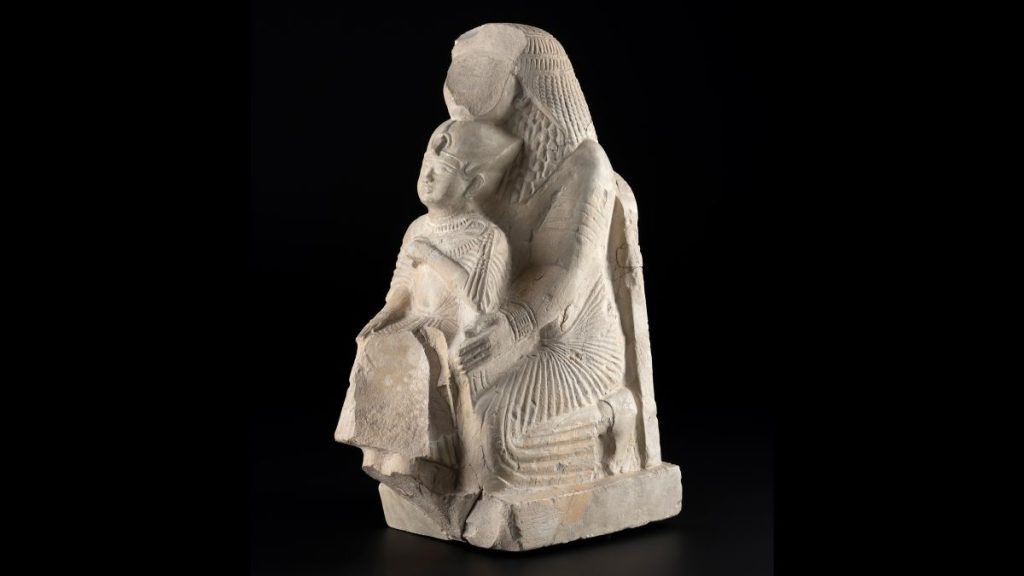The mystery of an “impossible” ancient Egyptian sculpture depicting two individuals, one of them a pharaoh, may now be solved, according to a researcher.
Not everyone agrees with the new assessment, however.
The 3D sculpture, carved out of limestone, shows the statue of a pharaoh seated on the lap of a kneeling person. The statue of the pharaoh is not life size, and is shown wearing a blue crown (sometimes called a war crown) with an uraeus (a snake) on top of it. The artwork is now housed in National Museums Scotland.
In ancient Egypt, pharaohs were not depicted alongside nonroyal people in 3D sculptures, Margaret Maitland (opens in new tab), principal curator of the ancient Mediterranean at National Museums Scotland, wrote in a paper published in the book “Deir el-Medina: Through the Kaleidoscope (opens in new tab)” (Franco Cosimo Panini Editore, 2022). Maitland also wrote a blog post (opens in new tab) about the sculpture in 2022, noting that the presence of a nonroyal person with a pharaoh made it seem like an “impossible” sculpture.
Maitland conducted archival research to determine where in Egypt the sculpture came from. She found that it was excavated at Deir el-Medina, a site near the Valley of the Kings, in the 1850s by a team led by Scottish archaeologist Alexander Henry Rhind. The ancient people who lived at Deir el-Medina were in charge of building tombs for the pharaohs, she noted.
Related: 10 times ancient Egyptian discoveries awed us in 2022
Maitland analyzed other sculptures found at Deir el-Medina, along with ancient historical records and other archaeological remains from the site. She found that some senior individuals at Deir el-Medina were allowed to depict the pharaoh in ways that people elsewhere in Egypt could not.
During the reign of Ramesses II (circa 1279 B.C. to 1213 B.C.), a statue-worshipping cult dedicated to the king flourished at Deir el-Medina. Worship of the pharaoh and construction of statues depicting him were encouraged by the royals, Maitland wrote.
“Considering the essential role the craftsmen played in constructing the royal tombs, as well as how central the burial of kings was to the Egyptian political system, it was important to maintain the stability of the social structure that governed Deir el-Medina by cultivating devotion to the king,” Maitland wrote in the book. In other words, even though Egyptians were normally discouraged from sculpting pharaohs and nonroyals together, at this specific time and place, it was condoned. Additionally the fact that this sculpture depicts the statue of the pharaoh, and not the pharaoh himself, makes its existence more acceptable, wrote Maitland in the book.
The pharaoh depicted in the sculpture is likely a statue of Ramesses II, Maitland wrote. The person shown kneeling behind the pharaoh is probably Ramose, a senior scribe who was a leader of the community, she added.
A big clue hints at Ramose’s identity, Maitland said. The person is shown wearing a floral wreath, a rare item for men to don in ancient Egypt. There is, however, a wooden statue from Deir el-Medina that shows Ramose wearing a wreath, her research showed.
But this interpretation doesn’t sit right with other archaeologists.
Betsy Bryan (opens in new tab), a professor of Near Eastern studies at Johns Hopkins University who is not involved with this research, agreed that this sculpture depicts a man along with a statue of a pharaoh. While the pharaoh could be Ramesses II, it’s more likely a portrayal of Amenhotep I (reign circa 1525 B.C. to 1504 B.C.), Bryan said.
For starters, Amenhotep was “the patron deity of Deir el-Medina,” Bryan said. Additionally, this pharaoh may be deified, which only occurs only after death, Bryan noted. This means that if the sculpture was created during the reign of Ramesses II, the people at Deir el-Medina would choose a dead pharaoh, like Amenhotep I, to be depicted.
That said, it’s still possible that the “impossible” statue could represent Ramesses II, Maitland said. In her research she has found examples of sculptures depicting viziers, or senior officials, with statues of deified pharaohs who were still alive when the sculptures were made. This suggests that living pharaohs could also sometimes be considered deified. Additionally she found that Ramesses II is frequently depicted at Deir el-Medina wearing the blue crown.
Editor’s note: Updated at 1 p.m. EDT on May 1 to add additional information from Margaret Maitland, who said it’s possible that the statue does represent Ramesses II.

